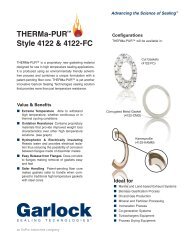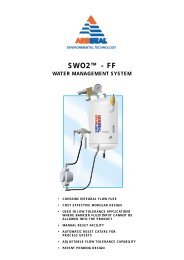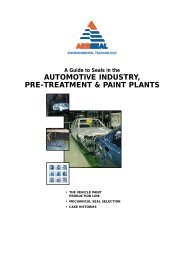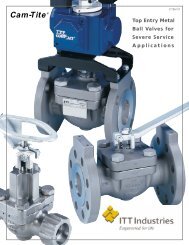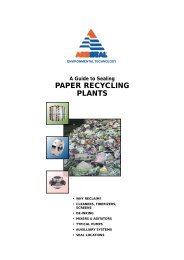expansion joints - AR Thomson Group
expansion joints - AR Thomson Group
expansion joints - AR Thomson Group
Create successful ePaper yourself
Turn your PDF publications into a flip-book with our unique Google optimized e-Paper software.
CONTROL UNITS<br />
Definition and Purpose<br />
A control unit is a system of two or more control rod<br />
(tie rod) assemblies placed across an <strong>expansion</strong> joint from<br />
flange to flange to prevent possible damage to the <strong>expansion</strong><br />
joint caused by excessive motion of the pipeline.<br />
Control units are always recommended since this excessive<br />
pipe motion could be caused by failure of an anchor<br />
or some other piece of equipment in the pipeline and<br />
would result in a catastrophic failure of the <strong>expansion</strong> joint<br />
if not used.<br />
Control units are not designed to replace recommended<br />
anchoring of a pipeline, but they must be used when<br />
proper anchoring cannot be provided. By restraining the<br />
Standard Design<br />
Figure 5 shows the proper assembly of an <strong>expansion</strong><br />
joint with standard design control units. The control<br />
unit system consists of a minimum of two tie rods<br />
with triangular plates and hex nuts with steel and rubber<br />
washers. The exact number and diameter of the tie<br />
rods and the thickness of the triangular plates is selected<br />
on the basis of the actual design/test pressure and<br />
other load requirements the system may be subjected<br />
6<br />
Bolt Circle<br />
Diameter<br />
Hex Nuts<br />
Joint O.D.<br />
Equally<br />
Spaced<br />
Bolt Holes<br />
Joint I.D.<br />
E<br />
piping system, the control unit will adequately protect the<br />
<strong>expansion</strong> joint from excessive elongation and compression<br />
movements caused by static pressure thrust or any<br />
other load.<br />
Rubber <strong>expansion</strong> <strong>joints</strong> are not designed to take end<br />
thrusts. In all cases where such are likely to occur, control<br />
units must be used to restrain the piping system. The control<br />
rod assemblies are set at the maximum allowable<br />
<strong>expansion</strong> and/or contraction of the <strong>expansion</strong> joint. When<br />
used in this manner, they are an additional safety factor,<br />
preventing catastrophic failure of the <strong>expansion</strong> joint and<br />
minimizing possible damage to the equipment.<br />
to. Always specify all load requirements when ordering<br />
control unit assemblies.<br />
The tie rods are usually fabricated from highstrength<br />
ASTM A193-B7 alloy bolts. They are set for<br />
the maximum allowable elongation of an <strong>expansion</strong><br />
joint and are designed to accept the static pressure<br />
thrust in addition to other external loads which would<br />
cause the joint to over-elongate.<br />
Figure 5<br />
Expansion joint with assembly of standard control unit components.<br />
C<br />
FF<br />
Expansion Joint<br />
Optional Compression<br />
Sleeve<br />
Control Rod<br />
Rubber Washer<br />
Steel Washer<br />
Pipe Flange<br />
Control Rod Plate



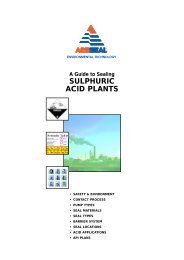
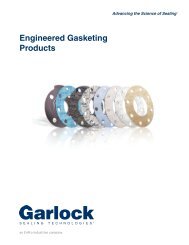
![VCS Flange Gasket [1.03 MB] - AR Thomson Group](https://img.yumpu.com/12044617/1/190x245/vcs-flange-gasket-103-mb-ar-thomson-group.jpg?quality=85)

![PGE Flange Gasket Product Brochure [1.04 MB] - AR Thomson Group](https://img.yumpu.com/12044595/1/190x245/pge-flange-gasket-product-brochure-104-mb-ar-thomson-group.jpg?quality=85)
